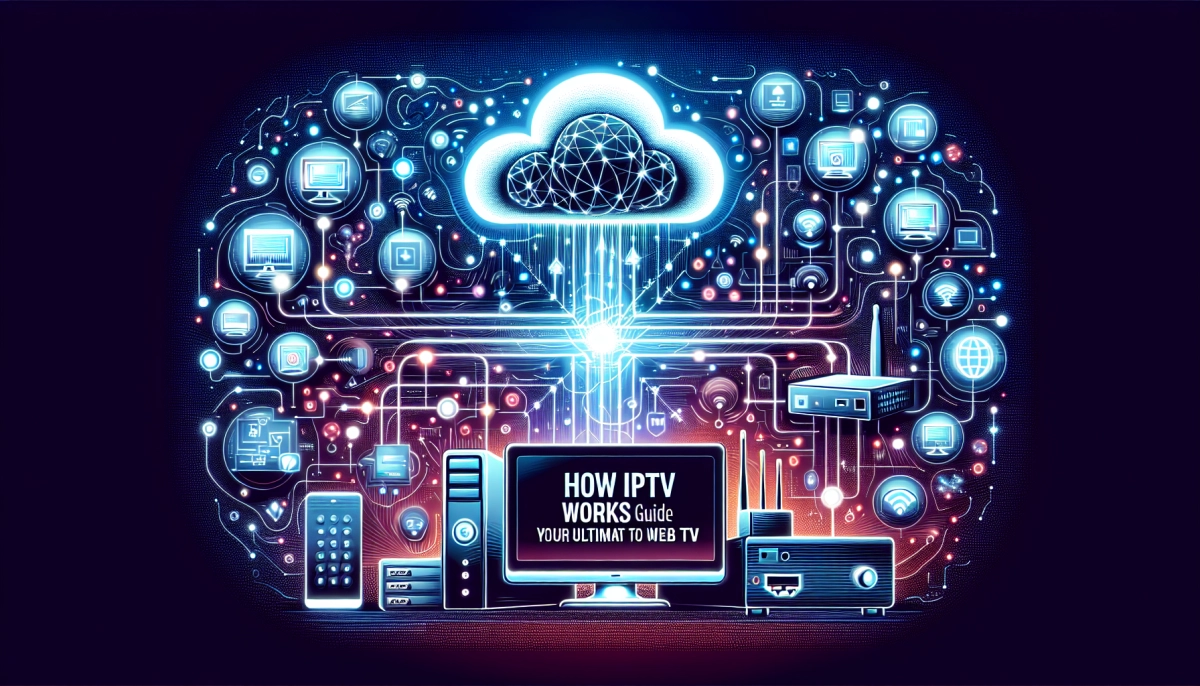Table of Contents
How IPTV Works
IPTV, or Internet Protocol Television, has transformed the way viewers consume television content by leveraging internet networks instead of traditional broadcasting methods 1. Unlike conventional TV that relies on radio waves, IPTV delivers TV programs live or on-demand by breaking up the content into data packets sent through the internet 2. This technology enables viewers to access their favorite shows on various devices such as computers, mobile devices, or via a set-top box connected to their TV 2. Understanding how IPTV works is essential for those looking to embrace this digital television revolution.
As the landscape of television viewing continues to evolve, this guide will delve into the mechanics behind IPTV, exploring the technology that powers it, the different types of IPTV services available, and the distinct advantages it holds over traditional TV broadcasting 2. Additionally, the article will shed light on the future trends, highlighting the growth and the challenges faced by IPTV, providing a comprehensive understanding of web TV and its burgeoning significance.
Understanding IPTV Technology
Understanding the technology behind IPTV reveals its innovative approach to delivering digital television services. Unlike traditional television that relies on broadcast signals, IPTV utilizes Internet Protocol (IP) technology, making it a game-changer in how content is distributed and accessed. Here’s a closer look at the IPTV architecture and its operation:
- IPTV Services Providers:
- Source: Telecommunications companies, Internet Service Providers (ISPs), and over-the-top (OTT) content providers are the primary sources of IPTV services, offering various subscription models including monthly or yearly packages and pay-per-view options 1.
- Compatibility: IPTV is designed to work seamlessly across a broad spectrum of devices such as Android Phones and TVs, MAC PCs, iOS devices, Samsung Tizen TV, LG WebOS, and Amazon Fire OS-powered devices 3.
- Legal Operation: Reputable IPTV service providers operate within legal frameworks, ensuring that subscriptions contribute to the rightful creators and distributors of the content 5.
- Core IPTV Technology:
- Delivery Mechanism: Utilizing IP multicasting with Internet Group Management Protocol for live broadcasts and Real-Time Streaming Protocol for on-demand content, IPTV efficiently manages the distribution of television services 4.
- Network Use: IPTV can operate over both public internet connections and private managed networks, offering flexibility in service delivery. The technology supports various video transmission protocols, including RTSP, HTTP, RTP, UDP, and IGMP, to facilitate content delivery 26.
- Content Streaming: At its core, IPTV involves storing, preparing, and streaming content to viewers. Programs are stored in digital format, compressed, encrypted, and then streamed using protocols such as RTP and RTSP. This process allows for a continuous stream of content, downloading a portion of the file, playing it, and simultaneously preparing the next part for viewing 2.
- IPTV Architecture:
- The Super Head-End: This is where national channel programs are downloaded, processed, and distributed to local offices. It serves as the central repository and processing center for IPTV content 7.
- Video Serving Office: At this stage, local content, video on demand, and advertising servers are integrated, preparing the content for distribution to end-users 7.
- Local End Office and Subscriber’s Home: The local end office merges data, telephony, and IP video services, transmitting them to the subscriber’s home through a DSL modem or set-top box. The IPTV set-top box then converts the incoming IP signal into a video signal that televisions can display, supporting high-speed internet connectivity 7.
This detailed breakdown of IPTV technology underscores its vast departure from traditional television broadcasting methods, leveraging the power of the internet to offer a flexible, diverse, and user-centric viewing experience.
How IPTV Works
- Device Compatibility:
- IPTV services can be enjoyed on a wide array of devices, enhancing flexibility and convenience for users. This includes smart TVs, streaming devices like Roku and Amazon Fire TV, smartphones, tablets, computers, and gaming consoles 9.
- The diverse device compatibility ensures that users can access IPTV services in the comfort of their living room or on the go, making it a versatile option for all types of viewers 9.
- Streaming Protocols:
- To deliver content seamlessly to users’ devices, IPTV services utilize various streaming protocols. These include HTTP Live Streaming (HLS), Real-Time Messaging Protocol (RTMP), and User Datagram Protocol (UDP) 9.
- Each protocol plays a crucial role in ensuring that content is delivered efficiently, maintaining the quality of both video and audio for an optimal viewing experience 9.
- Viewing Experience:
- Content Selection: Users have the liberty to browse through a broad spectrum of channels or content categories, selecting what they wish to watch with just a few clicks. This instant access to content is a significant advantage, offering a tailored viewing experience 9.
- Quality Factors: The overall quality of the IPTV service, including video clarity, audio fidelity, and streaming performance, can vary. Factors influencing this include the speed of the internet connection, server capacity, and the robustness of the service provider’s infrastructure 9.
- Connectivity Requirements: Given that IPTV relies on internet data transmission, a stable and fast internet connection is paramount for a smooth and uninterrupted viewing experience. This underscores the importance of having reliable internet service to enjoy IPTV to its fullest 6.
By leveraging advanced streaming protocols and offering flexibility across various devices, IPTV presents a modern, user-centric approach to television. Its ability to provide instant access to a wide range of content, coupled with the convenience of device compatibility, sets IPTV apart from traditional television delivery methods.
Types of IPTV Services
IPTV services have revolutionized the way we access television, offering a wide range of content through various formats and devices. Here’s a breakdown of the types of IPTV services available:
- Types of IPTV Services:
- Live Television: This service allows users to watch live TV programs over the internet as they’re being broadcasted. It’s akin to traditional TV but delivered through an internet protocol 2.
- Video On Demand (VOD): VOD services enable viewers to select and watch video content whenever they choose rather than at a scheduled broadcast time. This freedom to watch content on demand has made VOD a popular choice among users 2.
- Time-Shifted Television: Also known as catch-up TV, this service allows viewers to watch previously aired content at a time that suits them. It’s particularly useful for catching up on missed episodes or viewing entire series 2.
- Hybrid IPTV: Combining traditional broadcast TV services with video on demand, hybrid IPTV offers users access to both live channels and internet-based video content on their television sets, providing a comprehensive TV viewing experience 7.
- Delivery and Accessibility:
- Device Compatibility: IPTV services can be accessed on a variety of devices, including IP-enabled TVs, smartphones, tablets, laptops, and PCs, making it convenient for users to watch their favorite content on the go or from the comfort of their homes 11.
- Content Variety: IPTV offers an extensive range of content, including numerous TV channels, on-demand movies, international programs, and services tailored to different language speakers. This diversity ensures there’s something for everyone, from mainstream entertainment to niche interests 822.
- Market Segmentation:
- By Type: The market is segmented into subscription-based and subscription-free IPTV, catering to different user preferences and budget constraints 12.
- By Application: Key applications include Video on Demand, Time Shifted Television, and Live Television, each serving distinct viewing habits and preferences 12.
- End-User Type: Residential users constitute the leading segment, reflecting the widespread adoption of IPTV services in households 14.
Understanding the types of IPTV services and their delivery mechanisms provides insights into the flexibility and variety that IPTV offers over traditional TV. With advancements in technology and increasing internet speeds, IPTV continues to evolve, offering users an enriched and personalized viewing experience.
The Advantages of IPTV Over Traditional TV
IPTV, with its innovative approach, offers a plethora of advantages over traditional TV, making it a compelling choice for today’s digital-savvy viewers. Let’s explore some of these benefits in detail:
Device Flexibility and Accessibility
- Multiple Device Access: Unlike traditional TV that confines viewers to a television set, IPTV extends the viewing experience across various devices including smartphones, tablets, Smart TVs, and computers 23. This flexibility ensures that viewers can enjoy their favorite content anytime, anywhere, provided they have an internet connection 23.
- Seamless Multi-Device Viewing: For households with multiple screens, IPTV allows for a seamless viewing experience across all devices. This means one can start watching a show on their smartphone and easily switch to a Smart TV without losing track of the content 24.
Personalized and Interactive Viewing Experience
- Customized Content: IPTV services can be tailored to suit individual preferences, offering viewers a personalized content lineup. This customization extends to interactive features such as program guides, notifications, and the ability to pause and rewind live TV, enhancing the overall user experience 822.
- Interactive Features: Beyond watching, IPTV introduces an interactive layer to viewing by allowing users to interact with the program, influence its content, and enjoy additional services like video on demand, live streaming, and in-program messaging 24. These features not only enrich the viewing experience but also bring a new dimension to how content is consumed and engaged with.
Cost-Effectiveness and Enhanced Quality
- Economical: With the increasing number of cord-cutters and the shift towards mobile ad spend, IPTV presents a more cost-effective solution compared to traditional cable or satellite TV subscriptions 1023. This affordability does not compromise on quality; IPTV delivers high-definition video and immersive audio experiences 23.
- Quality and Reliability: IPTV ensures a consistent and reliable streaming experience. High-definition picture quality and immersive sound are standard, providing an unmatched viewing experience that traditional broadcasting methods struggle to match 21.
These advantages highlight the transformative impact of IPTV on the traditional TV landscape. By offering a more flexible, personalized, and cost-effective viewing experience, IPTV is not just an alternative to traditional TV; it’s a superior choice for the modern viewer.
Future Trends and Challenges in IPTV
The IPTV market is poised for significant growth, with projections indicating a substantial increase in market value and subscriber base over the coming years. This growth is underpinned by a combination of factors driving the expansion and the emergence of challenges that could shape the future landscape of IPTV.
Market Growth and Key Drivers:
- Projected Market Value: The IPTV market is expected to surge from USD 62.98 billion in 2022 to an impressive USD 353.0 billion by 2032, marking a Compound Annual Growth Rate (CAGR) of 19.34% during the forecast period 13. This remarkable growth trajectory is further evidenced by another estimate, which forecasts the market to grow from USD 52154.2 million in 2023 to USD 243975.24 million in 2032, with a CAGR of 18.70% 14.
- Driving Factors: Several pivotal elements are propelling this market expansion, including the escalating demand for high-definition video content, the broadening penetration of broadband services, and continuous technological advancements 12. Additionally, growing Internet penetration, the rising demand for on-demand content, advancements in network technologies, and an increase in smart devices are also contributing significantly to the market’s growth 14.
Challenges and Restraints:
- Security Concerns and Infrastructure: While the market is on an upward trajectory, it faces challenges such as security concerns, high initial investment costs, and complex infrastructure requirements 12. Moreover, infrastructure limitations and regulatory hurdles present additional constraints that could potentially impede the market’s growth 13.
- Market Dynamics: The IPTV market’s landscape is also characterized by its competitive nature, with major players like China Telecom, China Unicom, and others leading the way 12. The market is not only growing in terms of value and technology but also in its geographical reach, with North America currently dominating, followed by Europe and Asia Pacific, which is anticipated to grow the fastest 14.
In conclusion, the IPTV market is at a pivotal juncture, with substantial growth on the horizon driven by technological advancements, an increasing demand for quality content, and global connectivity. However, it must navigate through challenges such as security, investment, and infrastructure complexities to realize its full potential. As the market continues to evolve, it will undoubtedly offer exciting opportunities for innovation and expansion in the digital television space.
Conclusion
Exploring the intricacies of IPTV has revealed its pivotal role in modernizing how we access and enjoy television content, underscoring a shift from traditional viewing paradigms to a more personalized, interactive, and versatile experience. The journey through the architecture of IPTV, its device compatibility, varied service types, and the benefits over conventional TV showcases its significant advantages. It brings to light the technology’s capacity to offer a diverse, high-quality viewing experience tailored to the viewer’s preferences and lifestyle, affirming its growing importance in the digital entertainment landscape.
As we look towards the future, the evolving IPTV market promises further innovation and growth, driven by the relentless demand for superior content and enhanced viewer experiences. Though challenges persist, the potential for IPTV to revolutionize television consumption remains vast, offering avenues for further research, development, and adoption. For viewers seeking the apex of digital television, embracing the opportunities IPTV presents assures a dynamic, enriched viewing experience, paving the way for a new era of entertainment.
FAQs
Do you offer IPTV subscriptions?
Yes, we offer IPTV subscriptions! For more information and to sign up, please visit our IPTV service page at Home page.
Is there a TV guide available with IPTV services?
Yes, IPTV services include software that runs on your IPTV device, which provides access to a TV guide and the ability to stream video content. However, to ensure compatibility with the most up-to-date TV guide data or features, the IPTV software should be kept current with the latest updates.
What type of content can you watch on IPTV?
IPTV offers a broad spectrum of television content that includes live TV channels, on-demand programs, and video-on-demand movies and TV shows. This content is accessible through devices connected to the internet, such as a set-top box, smart TV, or streaming media player.
How does IPTV deliver television services to a TV?
IPTV, or Internet Protocol television, delivers TV services using the internet protocol suite over networks like LAN or the internet. This method contrasts with traditional delivery means such as terrestrial, satellite signal, and cable television formats.
From where do IPTV providers source their channels?
IPTV providers typically maintain their own infrastructure, including servers and content delivery networks, to offer a variety of channels and on-demand content. They form partnerships with broadcasters and content providers to secure a rich and diverse library of content for their subscribers.
References
[1] – https://medium.com/@xtreame_hdtv/exploring-the-evolution-and-impact-of-iptv-in-usa-a-comprehensive-analysis-2c6af453f566 [2] – https://www.explainthatstuff.com/how-iptv-works.html [3] – https://www.muvi.com/blogs/what-is-iptv-how-iptv-works/ [4] – https://www.techtarget.com/searchnetworking/definition/IPTV-Internet-Protocol-television [5] – https://www.quora.com/What-is-iptv-and-how-do-I-get-it-1 [6] – https://www.firesticktricks.com/what-is-iptv.html [7] – https://www.softwaretestinghelp.com/iptv-tutorial/ [8] – https://medium.com/@plustvbox8/1-introduction-5361fdeb0bd9 [9] – https://www.quora.com/How-does-an-IPTV-subscription-service-work [10] – https://vimeo.com/blog/post/what-is-iptv/ [11] – https://uniguest.com/what-is-iptv/ [12] – https://www.linkedin.com/pulse/internet-protocol-television-iptv-market-outlook [13] – https://www.linkedin.com/pulse/iptv-market-research-growth-analysis-48bcc?trk=article-ssr-frontend-pulse_more-articles_related-content-card [14] – https://www.credenceresearch.com/report/internet-protocol-television-iptv-market [15] – https://www.youtube.com/watch?v=64tyAvWBjic [16] – https://www.softwaretestinghelp.com/best-iptv-service-providers/ [17] – https://www.vplayed.com/blog/best-iptv-services/ [18] – https://www.firesticktricks.com/best-iptv-service.html [19] – https://troypoint.com/iptv/ [20] – https://www.redswitches.com/blog/what-is-iptv/ [21] – https://www.ask.com/entertainment/exploring-benefits-iptv-tv-comprehensive-overview [22] – https://www.fmradiobroadcast.com/article/detail/iptv-vs-traditional-cable-a-comprehensive-guide-for-hotels.html [23] – https://www.quora.com/What-are-the-key-benefits-of-using-IPTV-for-streaming-TV-content-and-how-does-it-compare-to-traditional-cable-or-satellite-TV-services [24] – https://medium.com/@iptv-setup-guide/iptv-vs-traditional-tv-unveiling-the-ultimate-viewing-experience-0e51541e2821



